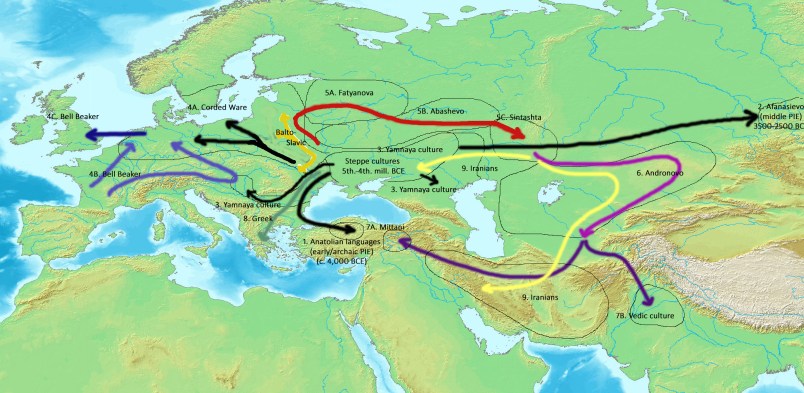From the outset of the Ukraine Crisis, Ukraine’s relationship with Europe and potential integration into Europe via the European Union has been a, perhaps the, cornerstone issue. I got to thinking about this over the weekend since almost every European language originated in the country we now call Ukraine. Don’t get me wrong. I don’t argue that what I’m describing has any particular relevance to the current crisis. But it’s a fascinating prism through which we can look at our connections to the distant past. The language which I am now writing and which you are now reading originated on the steppeland just north of the Black Sea and the Caspian Sea. In other words, in the region we now call Ukraine and some adjoining parts of Russia and perhaps Romania. This is true of English — a loose hodgepodge language — but not only English. All European languages except Finnish, Estonian, Hungarian and Basque start there. (Maltese, an official EU language, is derived from Arabic, a Semitic language. Turkish is an Altaic language so it depends what you count as “Europe.”) And not just Europe. This is also the origin point for the languages of Iran, much of Central Asia and northern India (including Hindi and Urdu). This is not to mention the Spanish, Portuguese and French that are spoken in the Western Hemisphere outside of Anglophone Canada and the United States.
This is the Indo-European language family which includes Germanic, Celtic, Slavic, Italic (the Romance langauges), Greek, Iranic, Indic and few other subfamilies. How this story and these interconnections were put together and how we’re pretty confident where it started is one of the most fascinating stories of human reasoning and intellection I have ever heard.
The story begins almost 250 years ago when a young Welshman who was a specialist and prodigy in the study of foreign languages, William Jones, was sent to India to learn Sanskrit as part of the British East India Company’s effort to run an Indian court system on the basis of Hindu legal precedents. The Hindu pandits of course knew Sanskrit perfectly well. But the British worried that the Indians would bamboozle them with phony precedents because they weren’t able to read the texts themselves. When Jones set to learning Sanskrit he quickly realized that this ancient language (the ancestor of Hindi and Urdu) was similar enough to Persian (which he also knew) and the Germanic languages (which include English) that they must all derive from a common ancestor. This insight sparked the birth of the modern field of linguistics. Over the next century scholars scoured the globe for languages in an effort to figure out whether they were part of the Indo-European linguistic family tree and where they fit into it. This search led to the eventual classification of the rest of the world’s languages into their own language families as well.
Along the way, specialists in the field we now call linguistics discovered a series of patterns by which languages change over time. So for instance a “kuh” sound will often evolve into an “ess” sound. But “kuh” won’t ever evolve into “puh” or “buh.” These patterns are built into the physical structure of our mouths and the circuitry of our brains. The specific rules don’t need to concern us here. But with these rules in hand these linguists were able to take the various Indo-European languages either spoken today or of which there is a written record, reverse engineer their evolution back to their common ancestor and in so doing reconstruct the language now called “proto-Indo-European” which was never written down and was spoken some five to six thousand years ago.
Think about it. That’s pretty F’ing amazing.
When we speak English, embedded in our words and grammar is a deep history, an archeology of the linguistic past which we carry within us, in the way we speak and think, without even knowing it. This is even more the case with English than most languages since English is a heavily infiltrated language. It starts as a West Germanic Language from what is now northern Germany and Denmark. But it’s successively overrun first by French (and thus ultimately by Latin) and then later directly by Latin and Greek with the importation of various technical, literary and scientific terms. Another Germanic language — Old Norse — played a key role loosening up English grammar. When we speak English this history is embedded in the words we use and the grammar we use to arrange and inflect those words — why we usually tack on an “s” to make a word plural but then also have weird outliers like “children” rather than “childs” and a bunch of other peculiarities.
Over the course of two centuries, as linguists pieced together an ever growing vocabulary from this common ancestral language, they began to learn things about the people who spoke that language from their vocabulary: horses, herding, wheeled wagons, patriarchal households and lineage, a raiding and nomadic culture. The animals they had words for, the metals they used and didn’t use allowed scholars to place these people with increasing specificity in place and time. And here is where the human archeology embedded in our language meets literal archeology.
Through much of the 19th and early 20th centuries the search for the original Indo-European homeland was filled with nationalistic myth-making and racist pseudoscience. But beginning in the early 20th century modern archeology began making real strides in charting the contours of pre-history. Over decades, linguistics has increasingly interacted with archeology to zero in on just the when and where of the origins of our language. Very recently, genetic research has added to the mix, both adding confirmation to what language and archeology appear to tell us as well as adding to the story of just why it may all have come about this way. (Lactose tolerance and intolerance seems to play a significant role in the story. Believe it or not.) Taken together these three disparate realms of human knowledge have each focused us down on this region just north of the Black Sea — Ukraine and bordering portions of Russia and Romania. There are still some who subscribe to an older, different theory which places the home of the Indo-Europeans in Anatolia (Turkey). But there is now a strong and growing consensus in favor of the theory I have sketched out above.
Final point: Are the Ukrainians the Indo-Europeans? Are they the same people? Direct ancestors? This is a complex question, the best answers to which are likely “sorta” and “maybe.” But it gets us into a topic of great fascination to me: language dispersion. So let’s discuss it briefly. Migration is the great fact of human history. There are no people truly indigenous to one particular piece of land, if you go back far enough and usually not even that far. Scholars used to believe that the history of human migration and language dispersion was one series of rolling genocides. One group migrates into the lands of a militarily/technologically less powerful group and either drives them off or puts them to the sword.
Historians used to believe this is what happened with the migration of “Anglo-Saxons” into Britain in the 5th and 6th centuries. But that’s seldom how it works, at least not entirely. The ancient and pre-historic world includes lots of mass killing. But languages tend to expand not through mass killing and displacement but through power — whether that’s military and political power or cultural or economic power. A particular fascination of mine is the history of English and precisely why and how the hybrid language we call “Anglo-Saxon” or “Old English” came to fully displace the languages of the Romano-British population even though most of the population remained the descendants of the people who lived there before the Anglo-Saxons showed up. While human migration is the great fact of history it’s also the case that genetic investigations have shown that prehistoric people from a given area are often closely related to a significant number of the people living on that patch of land today. So there is a certain kind of persistence often over thousands of years.
Obviously this depends a great deal on the history of the given patch of land, whether they are relatively isolated highland communities or people on the high-traffic violent thoroughfares of human history. Ukraine is part of the Great Eurasian Steppe, which stretches from the Carpathian Mountains just west of Ukraine all the way to China. This has been a thoroughfare of often violent migrations in each direction going back thousands of years. So there may be less persistence there than in other parts of the world. But almost certainly some significant percentage of the people now living in Ukraine are descendants of the people whose culture spawned the language you and I are reading and writing today.


 Members-Only Article
Members-Only Article

